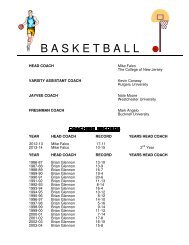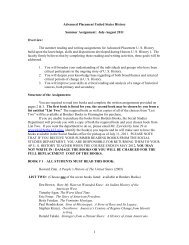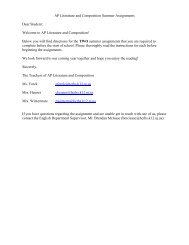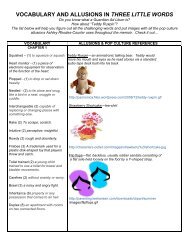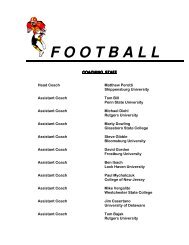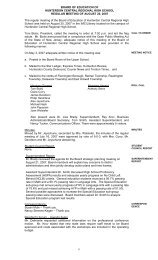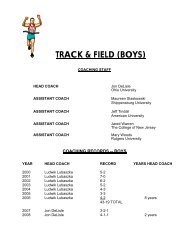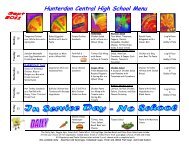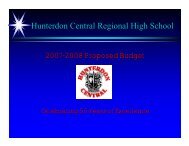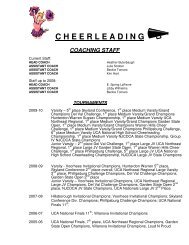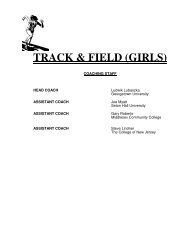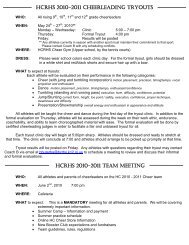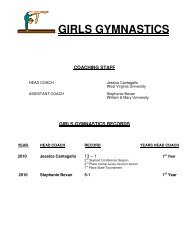HUNTERDON CENTRAL REGIONAL HIGH SCHOOL DISTRICT
HUNTERDON CENTRAL REGIONAL HIGH SCHOOL DISTRICT
HUNTERDON CENTRAL REGIONAL HIGH SCHOOL DISTRICT
You also want an ePaper? Increase the reach of your titles
YUMPU automatically turns print PDFs into web optimized ePapers that Google loves.
In many classes across all languages, the One-to-One Pilot program was the impetus for significant changes in<br />
the ways teachers delivered instruction and students participated in learning activities. The extensive use of<br />
teacher-developed Moodle sites also extended learning opportunities and experiences beyond the school day.<br />
Through the use of netbooks and Moodle, teachers have been able to provide students with access to authentic<br />
listening activities, opportunities to practice interpersonal speaking activities, and opportunities to use authentic<br />
sources for research and reading in preparation for presentational events.<br />
The ever expanding use of technology provides students and teachers with improved and relevant ways to share<br />
information. Students create comic strips, animate characters, provide voice-recorded PowerPoint presentations<br />
and access live reports of events in other countries, as well as taking advantage of the opportunity to hear and<br />
see how other countries represent events and activities in our country to gain an understanding of other<br />
perspectives and points of view. Students have used Elluminate to communicate with teachers on days when<br />
school was not in session. Students learned to select presentational formats such as Prezi and podcasts, along<br />
with Skype and Glogster, to share their learning. Social networking such as Twitter, DIIGO, YouTube and<br />
Facebook provided access to other learners around the world and provided a means for students to share their<br />
work with authentic audiences. These powerful tools and the teachers’ growing understanding of different<br />
learning styles and needs are leading the way in helping students to gain global understanding and the<br />
communication skills they will need in the future.<br />
New Program Highlights<br />
Spanish for Heritage Speakers was offered for the first time this year. Thirteen students completed the course.<br />
The course is designed to work with students who have heritage capability in Spanish. While these students may<br />
speak and understand the language well, there is often a gap in their reading and writing skills. Research<br />
indicates that improving the literacy skills of an individual’s first language will improve their likelihood of<br />
gaining higher achievement in second language skills. In view of Central’s concern regarding testing scores for<br />
the Hispanic subgroup, the Spanish for Heritage Speakers course focused on improving overall literacy as well<br />
as increasing the students’ understanding of the importance of achieving balanced bilingualism. The course<br />
addressed their needs more appropriately than would have been possible in a traditional Spanish class, which<br />
addresses the needs of English speaking students. Overall, the course was well received by the students. In the<br />
coming year, Heritage I will be offered as well as Heritage II.<br />
Spanish for Communicators continues to be an important option for special needs students to complete the<br />
World Language graduation requirement, and to gain basic communicative skills and cultural awareness. Since<br />
regulations regarding the needs of these classified students keep class size small, a pilot program ran this year<br />
which combined classes to provide a Spanish content area teacher for each section working with one Special<br />
Education teacher, serving the needs of two sections meeting in the same time and location. The co-teaching<br />
experiment was a cost-saving success and also benefited students by providing them with a year-long program<br />
during which two content teachers worked together to team teach the classes. Teachers were able to collaborate<br />
on planning, work with different instructional strategies, and experiment with ways to effectively meet the<br />
needs of the students. The approach was evaluated in March and teachers reported that they clearly saw benefits<br />
to the team approach, including the ability to maintain more instruction in the target language, build<br />
relationships with students, and maintain the momentum of instruction without the usual regrouping that occurs<br />
at the end of a semester when students are reassigned to new classes and teachers. The pilot will continue in the<br />
coming year.<br />
Next year, a new course will be offered to German students: Modern Germany for Today’s Young Adults. The<br />
course will serve to provide additional opportunities for German students and to support authentic use of<br />
language while gaining contemporary views and insights. Additionally, a quarter course is under development<br />
124



